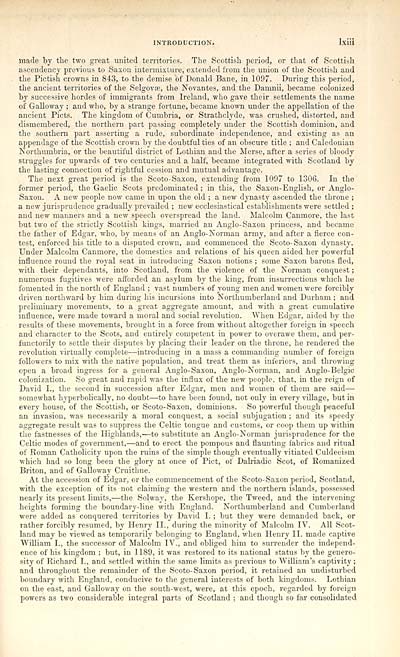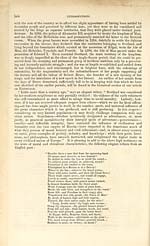Topographical, statistical, and historical gazetteer of Scotland > Volume 1
(75) Page lxiii
Download files
Complete book:
Individual page:
Thumbnail gallery: Grid view | List view

INTRODUCTION. Ixili
made by the two great united territories. The Scottish period, or that of Scottish
ascendency previous to Saxon intermixture, extended from the union of the Scottish and
the Pictish crowns in 843, to the demise of Donald Bane, in 1097. During this period,
the ancient territories of the SelgovEe, the Novantes, and the Damnii, became colonized
by successive hordes of immigrants from Ireland, who gave their settlements the name
of Galloway ; and who, by a strange fortune, became known under the appellation of the
ancient Picts. The kingdom of Cumbria, or Strathclyde, was crushed, distorted, and
dismembered, the northern part passing completely under the Scottish dominion, and
the southern part asserting a rude, subordinate independence, and existing as an
appendage of the Scottish crown by the doubtful ties of an obscure title ; and Caledonian
Northumbria, or the beautiful district of Lothian and the Merse, after a series of bloody
struggles for upwards of two centuries and a half, became integrated with Scotland by
the lasting connection of rightful cession and mutual advantage.
The next great period is the Scoto-Saxon, extending from 1097 to 1306. In the'
former period, the Gaelic Scots predominated ; in this, the Saxon- English, or Anglo-
Saxon. A new people now came in upon the old ; a new dynasty ascended the throne ;
a new jurisprudence gradually prevailed ; new ecclesiastical establishments were settled ;
and new manners and a new speech overspread the land. Malcolm Canmore, the last
but two of the strictly Scottish kings, married an Anglo-Saxon princess, and became
the father of Edgar, who, by means of an Anglo-Norman army, and after a fierce con-
test, enforced his title to a disputed crown, and commenced the Scoto-Saxon dynasty.
Under Malcolm Canmore, the domestics and relations of his queen aided her powerful
influence round the royal seat in introducing Saxon notions ; some Saxon barons fled,
with their dependants, into Scotland, from the violence of the Norman conquest ;
numerous fugitives were afforded an asylum by the king, from insurrections which he
fomented in the north of England ; vast numbers of young men and women were forcibly
driven northward by him during his incursions into Northumberland and Durham ; and
preliminary movements, to a great aggregate amount, and with a great cumulative
influence, were made toward a moral and social revolution. When Edgar, aided by the
results of these movements, brought in a force from without altogether foreign in speech
and character to the Scots, and entirely competent in power to overawe them, and per-
functorily to settle their disputes by placing their leader on the throne, he rendered the
revolution virtually complete — introducing in a mass a commanding number of foreign
followers to mix with the native population, and treat them as inferiors, and throwing
open a broad ingress for a general Anglo-Saxon, Anglo-Norman, and Anglo-Belgic
colonization. So great and rapid was the influx of the new people, that, in the reign of
David I., the second in succession after Edgar, men and women of them are said — ■
somewhat hyperbolically, no doubt — to have been found, not only in every village, but in
every house, of the Scottish, or Scoto-Saxon, dominions. So powerful though peaceful
an invasion, was necessarily a moral conquest, a social subjugation ; and its speedy
aggregate result was to suppress the Celtic tongue and customs, or coop them up within
the fastnesses of the Highlands, — to substitute an Anglo-Norman jurisprudence for the
Celtic modes of government, — and to erect the pompous and flaunting fabrics and ritual
of Roman Catholicity upon the ruins of the simple though eventually vitiated Culdeeism
which had so long been the glory at once of Pict, of DaLriadic Scot, of Romanized
Briton, and of Galloway Cruithne.
At the accession of Edgar, or the commencement of the Scoto-Saxon period, Scotland,
with the exception of its not claiming the western and the northern islands, possessed
nearly its present limits, — the Solway, the Kershope, the Tweed, and the intervening
heights forming the boundary-line with England. Northumberland and Cumberland
were added as conquered territories by David I. ; but they were demanded back, or
rather forcibly resumed, by Henry II., during the minority of Malcolm IV. All Scot-
land may be viewed as temporarily belonging to England, when Henry II. made captive
William I., the successor of Malcolm IV., and obliged him to surrender the independ-
ence of his kingdom ; but, in 1189, it was restored to its national status by the genero-
sity of Richard I., and settled within the same limits as previous to William's captivity;
and throughout the remainder of the Scoto-Saxon period, it retained an undisturbed
boundary with England, conducive to the general interests of both kingdoms. Lothian
on the east, and Galloway on the south-west, were, at this epoch, regarded by foreign
powers as two considerable integral parts of Scotland ; and though so far consolidated
made by the two great united territories. The Scottish period, or that of Scottish
ascendency previous to Saxon intermixture, extended from the union of the Scottish and
the Pictish crowns in 843, to the demise of Donald Bane, in 1097. During this period,
the ancient territories of the SelgovEe, the Novantes, and the Damnii, became colonized
by successive hordes of immigrants from Ireland, who gave their settlements the name
of Galloway ; and who, by a strange fortune, became known under the appellation of the
ancient Picts. The kingdom of Cumbria, or Strathclyde, was crushed, distorted, and
dismembered, the northern part passing completely under the Scottish dominion, and
the southern part asserting a rude, subordinate independence, and existing as an
appendage of the Scottish crown by the doubtful ties of an obscure title ; and Caledonian
Northumbria, or the beautiful district of Lothian and the Merse, after a series of bloody
struggles for upwards of two centuries and a half, became integrated with Scotland by
the lasting connection of rightful cession and mutual advantage.
The next great period is the Scoto-Saxon, extending from 1097 to 1306. In the'
former period, the Gaelic Scots predominated ; in this, the Saxon- English, or Anglo-
Saxon. A new people now came in upon the old ; a new dynasty ascended the throne ;
a new jurisprudence gradually prevailed ; new ecclesiastical establishments were settled ;
and new manners and a new speech overspread the land. Malcolm Canmore, the last
but two of the strictly Scottish kings, married an Anglo-Saxon princess, and became
the father of Edgar, who, by means of an Anglo-Norman army, and after a fierce con-
test, enforced his title to a disputed crown, and commenced the Scoto-Saxon dynasty.
Under Malcolm Canmore, the domestics and relations of his queen aided her powerful
influence round the royal seat in introducing Saxon notions ; some Saxon barons fled,
with their dependants, into Scotland, from the violence of the Norman conquest ;
numerous fugitives were afforded an asylum by the king, from insurrections which he
fomented in the north of England ; vast numbers of young men and women were forcibly
driven northward by him during his incursions into Northumberland and Durham ; and
preliminary movements, to a great aggregate amount, and with a great cumulative
influence, were made toward a moral and social revolution. When Edgar, aided by the
results of these movements, brought in a force from without altogether foreign in speech
and character to the Scots, and entirely competent in power to overawe them, and per-
functorily to settle their disputes by placing their leader on the throne, he rendered the
revolution virtually complete — introducing in a mass a commanding number of foreign
followers to mix with the native population, and treat them as inferiors, and throwing
open a broad ingress for a general Anglo-Saxon, Anglo-Norman, and Anglo-Belgic
colonization. So great and rapid was the influx of the new people, that, in the reign of
David I., the second in succession after Edgar, men and women of them are said — ■
somewhat hyperbolically, no doubt — to have been found, not only in every village, but in
every house, of the Scottish, or Scoto-Saxon, dominions. So powerful though peaceful
an invasion, was necessarily a moral conquest, a social subjugation ; and its speedy
aggregate result was to suppress the Celtic tongue and customs, or coop them up within
the fastnesses of the Highlands, — to substitute an Anglo-Norman jurisprudence for the
Celtic modes of government, — and to erect the pompous and flaunting fabrics and ritual
of Roman Catholicity upon the ruins of the simple though eventually vitiated Culdeeism
which had so long been the glory at once of Pict, of DaLriadic Scot, of Romanized
Briton, and of Galloway Cruithne.
At the accession of Edgar, or the commencement of the Scoto-Saxon period, Scotland,
with the exception of its not claiming the western and the northern islands, possessed
nearly its present limits, — the Solway, the Kershope, the Tweed, and the intervening
heights forming the boundary-line with England. Northumberland and Cumberland
were added as conquered territories by David I. ; but they were demanded back, or
rather forcibly resumed, by Henry II., during the minority of Malcolm IV. All Scot-
land may be viewed as temporarily belonging to England, when Henry II. made captive
William I., the successor of Malcolm IV., and obliged him to surrender the independ-
ence of his kingdom ; but, in 1189, it was restored to its national status by the genero-
sity of Richard I., and settled within the same limits as previous to William's captivity;
and throughout the remainder of the Scoto-Saxon period, it retained an undisturbed
boundary with England, conducive to the general interests of both kingdoms. Lothian
on the east, and Galloway on the south-west, were, at this epoch, regarded by foreign
powers as two considerable integral parts of Scotland ; and though so far consolidated
Set display mode to: Large image | Transcription
Images and transcriptions on this page, including medium image downloads, may be used under the Creative Commons Attribution 4.0 International Licence unless otherwise stated. ![]()
| Gazetteers of Scotland, 1803-1901 > Topographical, statistical, and historical gazetteer of Scotland > Volume 1 > (75) Page lxiii |
|---|
| Permanent URL | https://digital.nls.uk/97438446 |
|---|
| Description | Volume first. A-H. |
|---|---|
| Attribution and copyright: |
|

